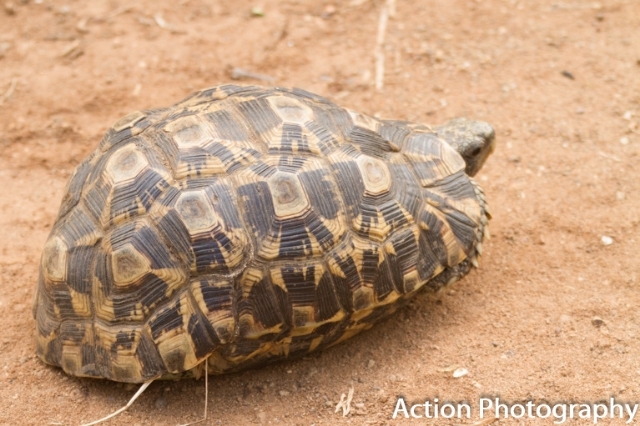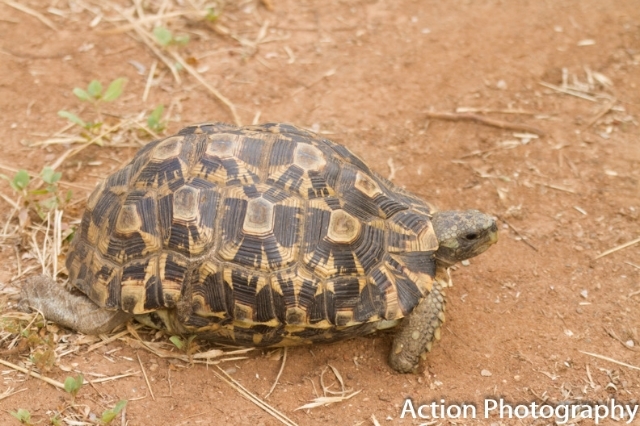Re: AW Reptile Book: Turtles & Tortoises - Pics & Descriptio
Posted: Thu Apr 09, 2015 4:54 pm
Eastern Hinged-back Tortoise Kinixys zombensis
Family: Testudinidae
 © RogerFraser
© RogerFraser
 © RogerFraser
© RogerFraser
uMkhuze, KwaZulu-Natal
Description
A medium-sized tortoise. The beak is unicuspid and not serrated. Forelimbs with five digits, hindlimbs have four digits. The carapace is domed with sloping sides and flattened dorsally with broad black radial patterns. As this species ages, it tends to develop a lumpy or pyramided appearance. The color patterns can vary between individuals from brown to yellow. The plastron is very dark in juveniles and lightens in color with age. Front lobe of the plastron is truncated and extends to or projects beyond carapace; uniform light color or black splashes radiating outward. The hinge is well developed, between 7th and 8th marginal shield.
Size
Males: 206 mm. Females: 217 mm.
Geographic distribution
East African coastal plain from Tanzania to Zululand. It is known to occur in Kenya, Tanzania, Malawi, Mozambique, Zimbabwe and South Africa. Range extends into the far northeastern region of the KwaZulu-Natal Province and specimens have been reported to occur in St. Lucia Park.
Habitat
Moist savannah woodlands, coastal grasslands, and dune forest edge.
Behaviour
These tortoises tend to be crepuscular and are most active in the early morning or late afternoon during the coolest times of the day. Activity peaks for these species during the wet season while they are known to aestivate during the dry season using animal burrows, dead logs, and leaf litter.
Diet
A varied diet of plant matter, fungi, invertebrates, and these tortoises are also known to feed on small animal carcasses when encountered.
Reproduction
Mating is observed from November to April. Multiple clutches are laid with 2 to 10 eggs in each clutch. Incubation times for individuals are typically 90-110 days.
Links: The Conservation Biology of Tortoises. Ian Richard Swingland, Michael W. Klemens, IUCN/SSC Tortoise and Freshwater Turtle Specialist Group; Field Guide to Snakes and Other Reptiles of Southern Africa. William R. Branch
Family: Testudinidae
 © RogerFraser
© RogerFraser © RogerFraser
© RogerFraseruMkhuze, KwaZulu-Natal
Description
A medium-sized tortoise. The beak is unicuspid and not serrated. Forelimbs with five digits, hindlimbs have four digits. The carapace is domed with sloping sides and flattened dorsally with broad black radial patterns. As this species ages, it tends to develop a lumpy or pyramided appearance. The color patterns can vary between individuals from brown to yellow. The plastron is very dark in juveniles and lightens in color with age. Front lobe of the plastron is truncated and extends to or projects beyond carapace; uniform light color or black splashes radiating outward. The hinge is well developed, between 7th and 8th marginal shield.
Size
Males: 206 mm. Females: 217 mm.
Geographic distribution
East African coastal plain from Tanzania to Zululand. It is known to occur in Kenya, Tanzania, Malawi, Mozambique, Zimbabwe and South Africa. Range extends into the far northeastern region of the KwaZulu-Natal Province and specimens have been reported to occur in St. Lucia Park.
Habitat
Moist savannah woodlands, coastal grasslands, and dune forest edge.
Behaviour
These tortoises tend to be crepuscular and are most active in the early morning or late afternoon during the coolest times of the day. Activity peaks for these species during the wet season while they are known to aestivate during the dry season using animal burrows, dead logs, and leaf litter.
Diet
A varied diet of plant matter, fungi, invertebrates, and these tortoises are also known to feed on small animal carcasses when encountered.
Reproduction
Mating is observed from November to April. Multiple clutches are laid with 2 to 10 eggs in each clutch. Incubation times for individuals are typically 90-110 days.
Links: The Conservation Biology of Tortoises. Ian Richard Swingland, Michael W. Klemens, IUCN/SSC Tortoise and Freshwater Turtle Specialist Group; Field Guide to Snakes and Other Reptiles of Southern Africa. William R. Branch